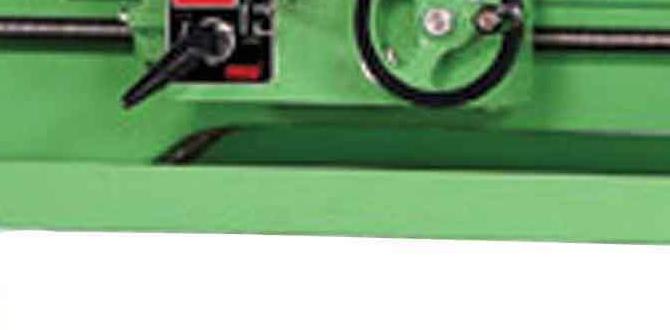Quick Summary: A 3/16 inch carbide end mill, especially with an 8mm shank and standard length, is a fantastic choice for cutting steel. Its hardness and heat resistance make it ideal for tackling tough materials like carbon steel and even heat-resistant alloys, providing clean cuts and a long tool life.
Hey there, fellow makers and machinists! Daniel Bates here from Lathe Hub. Ever stared at a piece of steel, keen to shape it, only to feel a bit daunted by the tools? You’re not alone. Choosing the right cutting tool can seem tricky, but some tools are real workhorses, especially for a common material like steel. Today, we’re diving into a super handy tool that punches way above its weight class: the 3/16 inch carbide end mill. If you’re looking to mill steel with confidence and get clean, precise results, this little tool might just become your new best friend. We’ll show you why and how to use it effectively.
In this guide, we’ll break down what makes a 3/16 inch carbide end mill so special for steel, what to look for when buying one, and how to use it safely. Whether you’re working with basic carbon steel or something a bit tougher, we’ve got you covered. Let’s get those chips flying!
Why a 3/16 Inch Carbide End Mill is Your Steel-Cutting Champion
When you’re working with metal, especially tougher ones like steel, the cutting tool needs some serious grit. That’s where carbide comes in. Carbide (specifically, tungsten carbide) is incredibly hard and can withstand high temperatures without losing its edge. This is a massive advantage over traditional High-Speed Steel (HSS) tools when it comes to milling steel.
A 3/16 inch (which is roughly 5mm) diameter end mill is a versatile size. Not too big to be unwieldy, not too small to be fragile, it’s perfect for a wide range of tasks, from cutting slots and pockets to edge profiling. When you combine this practical size with the superior properties of carbide, you get a tool that’s exceptionally good at cutting steel.
Carbide vs. HSS for Steel: What’s the Big Deal?
If you’ve ever tried to mill steel with an HSS end mill, you might have noticed it can get hot, dull quickly, or even break. This is because steel is hard, and the friction created during cutting generates a lot of heat. HSS tools can soften and lose their cutting ability at elevated temperatures.
Carbide, on the other hand, has a much higher hardness and heat resistance. This means:
- Longer Tool Life: It stays sharp much longer when cutting steel.
- Higher Cutting Speeds: You can often cut faster with carbide, meaning quicker project completion.
- Better Surface Finish: The rigidity and sharpness of carbide generally lead to cleaner, smoother cuts.
- Less Chatter: A rigid carbide tool can reduce vibration, leading to more accurate parts.
While carbide tools are typically more expensive upfront than HSS, their longevity and improved performance on tough materials like steel often make them more cost-effective in the long run, especially for production or frequent use.
The Advantages of an 8mm Shank
You’ll often find 3/16 inch end mills offered with various shank sizes. A common and practical choice is an 8mm shank. Why is this relevant?
- Machine Compatibility: Many small milling machines, especially those popular with hobbyists and in educational settings, are designed to hold 8mm or 1/4 inch collets. An 8mm shank fits snugly in machines equipped for it, offering a secure grip.
- Rigidity: A larger shank diameter generally provides more rigidity. For a small tool like a 3/16 inch end mill, an 8mm shank offers a good balance, ensuring the tool doesn’t flex excessively during cutting, which is crucial for accuracy.
- Holding Power: A properly sized collet and an 8mm shank work together to provide excellent holding power, reducing the risk of the end mill slipping.
When looking for your 3/16 inch carbide end mill, specifying an 8mm shank means you’re likely getting a tool that’s well-suited for common small milling machine setups and provides a good foundation for stable cutting.
Choosing the Right 3/16 Inch Carbide End Mill for Steel
Not all carbide end mills are created equal, especially when it comes to steel. Here’s what to consider:
1. Number of Flutes
Flutes are the helical grooves that run along the cutting edges of the end mill. The number of flutes affects how it cuts, especially in different materials. This is a critical factor when choosing an end mill for steel.
- 2 Flutes: These are often preferred for milling softer materials like aluminum because they provide good chip clearance. However, they can also work well in steel, especially for slotting, as they offer more room for chips to escape. This is vital to prevent chip recutting and overheating.
- 4 Flutes: These are generally better for finishing operations and can handle harder materials than 2-flute end mills. They provide a smoother finish and better stability. While good for steel, you need to be mindful of chip evacuation, especially in deeper cuts or sticky materials. For steel, a 4-flute can offer a good balance for general-purpose milling.
Recommendation for Steel: For general-purpose milling of steel, especially for beginners, a 4-flute end mill offers a good balance of cutting ability and material compatibility. If you’re primarily doing slotting or working with materials that tend to “gum up” the tool, a 2-flute might be considered, but ensure excellent chip evacuation. For this guide, we’ll focus on the versatility often found in 4-flute options.
2. End Mill Geometry
The shape of the cutting end and the helix angle contribute to how the end mill performs:
- Square End Mills: These have a flat tip and are the most common type. They are excellent for creating square shoulders, pockets, and general profiling.
- Ball Nose End Mills: These have a rounded tip and are used for creating 3D contours, fillets, and smoother surface finishes.
- Corner Radius End Mills: These are similar to square end mills but have a small radius at the corners. This helps to prevent chipping at the corners and can improve tool life when milling corners of slots or profiles.
Recommendation for Steel: For most beginner tasks involving steel, a square end mill is the most versatile. If you plan on doing 3D carving, a ball nose is essential. A corner radius can be beneficial for robustness, especially in smaller sizes.
3. Coatings
Coatings are thin layers applied to the surface of the end mill to enhance its performance:
- Uncoated: Basic, but a good carbide end mill can still perform well.
- TiN (Titanium Nitride): A common, general-purpose coating that adds hardness and reduces friction, offering some improvement in tool life and speed.
- TiCN (Titanium Carbon Nitride): Harder than TiN, offering better wear resistance and suitable for abrasive materials.
- AlTiN (Aluminum Titanium Nitride): Excellent for high-temperature applications, making it a top choice for milling tougher steels, especially stainless steel and heat-resistant alloys. It forms a protective oxide layer at high temperatures.
- ZrN (Zirconium Nitride): Similar to TiN but can be better for certain materials.
Recommendation for Steel: For general carbon steel, an uncoated or TiN coated end mill can work reasonably well. However, if you’re dealing with harder steels, stainless steel, or looking for maximum tool life and the ability to run slightly higher speeds, an AlTiN (or TiCN) coating is highly recommended. AlTiN is particularly good for materials that generate a lot of heat.
4. Material of the Workpiece
While we’re focusing on steel, it’s good to know that “steel” is a broad category. A 3/16 inch carbide end mill is essential for these types:
- Carbon Steels: These are generally the most common and easiest to machine steels. Examples include ASTM A36, 1018, 1045. A standard 4-flute carbide end mill is excellent here.
- Alloy Steels: Steels with added elements like chromium, nickel, or molybdenum for enhanced properties. Machining can be tougher.
- Stainless Steels: Known for their corrosion resistance, but also for being tough and “gummy” to machine. They require good lubrication and can work-harden.
- Heat-Resistant Alloys (e.g., Inconel, certain tool steels): These are very hard and difficult to machine, requiring specialized tooling, slower speeds, and aggressive cooling. A robust carbide end mill with an AlTiN coating is almost a must.
A standard 3/16 inch carbide end mill is a fantastic general-purpose tool. For very hard or gummy steels, you might need specific grades of carbide or coatings, but this size is your starting point.
Essential Setup and Safe Machining Practices
Using any cutting tool, especially on metal, requires careful setup and adherence to safety. Carbide is brittle, and steel can be unforgiving if not handled correctly.
Safety First!
Before we even touch the machine, let’s talk safety. This is non-negotiable.
- Eye Protection: Always wear safety glasses or a face shield. Flying chips are a real hazard.
- Hearing Protection: Milling can be noisy.
- No Loose Clothing or Jewelry: These can get caught in the machine. Tie back long hair.
- Know Your Machine: Understand its controls, emergency stop, and limitations.
- Secure Workpiece: Ensure your workpiece is firmly clamped. A dropped workpiece can cause serious damage or injury.
- Proper Tooling: Use a collet that matches the shank size (e.g., an 8mm collet for an 8mm shank). Ensure the collet is clean and the end mill is seated properly.
- Coolant/Lubrication: Crucial for steel. It cools the cutting edge, lubricates, and helps evacuate chips.
Setting Up Your 3/16 Inch Carbide End Mill
Here’s a basic setup checklist:
- Choose the Right Collet: Select an 8mm collet (or the exact size of your end mill shank).
- Clean Everything: Ensure the collet, collet nut, and spindle taper are clean. Any swarf or debris can affect runout and grip.
- Install the Collet: Insert the collet into the collet nut.
- Insert the End Mill: Place the 3/16 inch carbide end mill into the collet. Ensure it’s seated as far as possible without bottoming out. You don’t want too much overhang.
- Tighten the Collet Nut: Thread the collet nut into the spindle or tool holder. Tighten it firmly, but avoid over-tightening, which can damage the collet. Refer to your machine’s manual for torque recommendations if available.
- Secure Your Workpiece: Use a vise, clamps, or a fixture to hold your steel workpiece securely on the milling machine table.
Basic Machining Parameters for Steel
Getting the “feeds and speeds” right is key to success. These are starting points and will vary based on your machine’s rigidity, the specific steel, and the coolant used. Carbide tools generally benefit from higher speeds and lower feed rates per tooth compared to HSS, but it’s always best to start conservatively.
Here’s a very general guideline for a 4-flute 3/16 inch carbide end mill in common carbon steel (like 1018 or mild steel):
| Parameter | Typical Value | Notes |
|---|---|---|
| Surface Speed (SFM) | 250-400 | Adjust based on coolant and material |
| Spindle RPM | [Formula below] | Calculates RPM from SFM |
| Feed Per Tooth (IPT) | 0.001 – 0.002 | For 1/8″ deep cuts. Adjust for depth. |
| Chip Load (IPM) | [Formula below] | Calculates IPM from IPT and RPM |
| Axial Depth of Cut (DOC) | 0.050 – 0.100 inches | Start conservatively |
| Radial Depth of Cut (WOC) | 0.075 – 0.150 inches (50%-75% of tool diameter) | For slotting, use 100% |
Calculating Speeds and Feeds:
Here are the basic formulas:
- RPM = (SFM 3.82) / Tool Diameter (inches)
- IPM = RPM Number of Flutes Feed Per Tooth (IPT)
Let’s plug in some numbers for a 3/16″ (0.1875″) end mill (4 flutes) at the lower end of the SFM range (250 SFM):
- RPM = (250 3.82) / 0.1875 = 5100 RPM
- If we aim for 0.0015 IPT:
- IPM = 5100 4 0.0015 = 30.6 IPM
So, a good starting point might be around 5000 RPM with a feed rate of about 30 IPM for a 0.100″ depth of cut.
Always experiment! Listen to the cut. If it sounds harsh or chips are too fine and dusty, you might be feeding too fast or going too deep for the speed. If it’s rubbing or sounds “scream-y,” you might need to increase speed or feed, or you’re not using enough coolant.
Coolant and Lubrication
For steel, a good cutting fluid is essential. It helps:
- Cool the tool and workpiece: Prevents heat buildup, which preserves the carbide edge and reduces the risk of thermal expansion issues.
- Lubricate the cutting zone: Reduces friction, allowing for smoother cutting and a better surface finish.
- Flush chips away: Prevents chips from getting recut or clogging flutes, which can lead to tool breakage.
Common options include:
- Soluble Oils: Diluted with water, these are good general-purpose coolants for steel.
- Synthetic Coolants: Offer excellent cooling and cleanliness.







